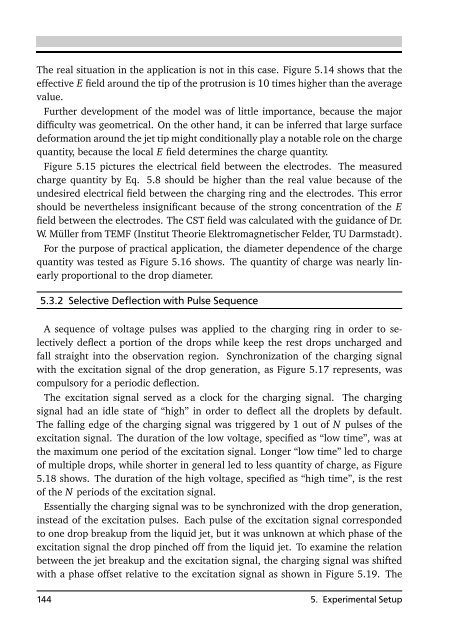front page - tuprints - Technische Universität Darmstadt
front page - tuprints - Technische Universität Darmstadt
front page - tuprints - Technische Universität Darmstadt
Create successful ePaper yourself
Turn your PDF publications into a flip-book with our unique Google optimized e-Paper software.
The real situation in the application is not in this case. Figure 5.14 shows that the<br />
effective E field around the tip of the protrusion is 10 times higher than the average<br />
value.<br />
Further development of the model was of little importance, because the major<br />
difficulty was geometrical. On the other hand, it can be inferred that large surface<br />
deformation around the jet tip might conditionally play a notable role on the charge<br />
quantity, because the local E field determines the charge quantity.<br />
Figure 5.15 pictures the electrical field between the electrodes. The measured<br />
charge quantity by Eq. 5.8 should be higher than the real value because of the<br />
undesired electrical field between the charging ring and the electrodes. This error<br />
should be nevertheless insignificant because of the strong concentration of the E<br />
field between the electrodes. The CST field was calculated with the guidance of Dr.<br />
W. Müller from TEMF (Institut Theorie Elektromagnetischer Felder, TU <strong>Darmstadt</strong>).<br />
For the purpose of practical application, the diameter dependence of the charge<br />
quantity was tested as Figure 5.16 shows. The quantity of charge was nearly linearly<br />
proportional to the drop diameter.<br />
5.3.2 Selective Deflection with Pulse Sequence<br />
A sequence of voltage pulses was applied to the charging ring in order to selectively<br />
deflect a portion of the drops while keep the rest drops uncharged and<br />
fall straight into the observation region. Synchronization of the charging signal<br />
with the excitation signal of the drop generation, as Figure 5.17 represents, was<br />
compulsory for a periodic deflection.<br />
The excitation signal served as a clock for the charging signal. The charging<br />
signal had an idle state of “high” in order to deflect all the droplets by default.<br />
The falling edge of the charging signal was triggered by 1 out of N pulses of the<br />
excitation signal. The duration of the low voltage, specified as “low time”, was at<br />
the maximum one period of the excitation signal. Longer “low time” led to charge<br />
of multiple drops, while shorter in general led to less quantity of charge, as Figure<br />
5.18 shows. The duration of the high voltage, specified as “high time”, is the rest<br />
of the N periods of the excitation signal.<br />
Essentially the charging signal was to be synchronized with the drop generation,<br />
instead of the excitation pulses. Each pulse of the excitation signal corresponded<br />
to one drop breakup from the liquid jet, but it was unknown at which phase of the<br />
excitation signal the drop pinched off from the liquid jet. To examine the relation<br />
between the jet breakup and the excitation signal, the charging signal was shifted<br />
with a phase offset relative to the excitation signal as shown in Figure 5.19. The<br />
144 5. Experimental Setup
















